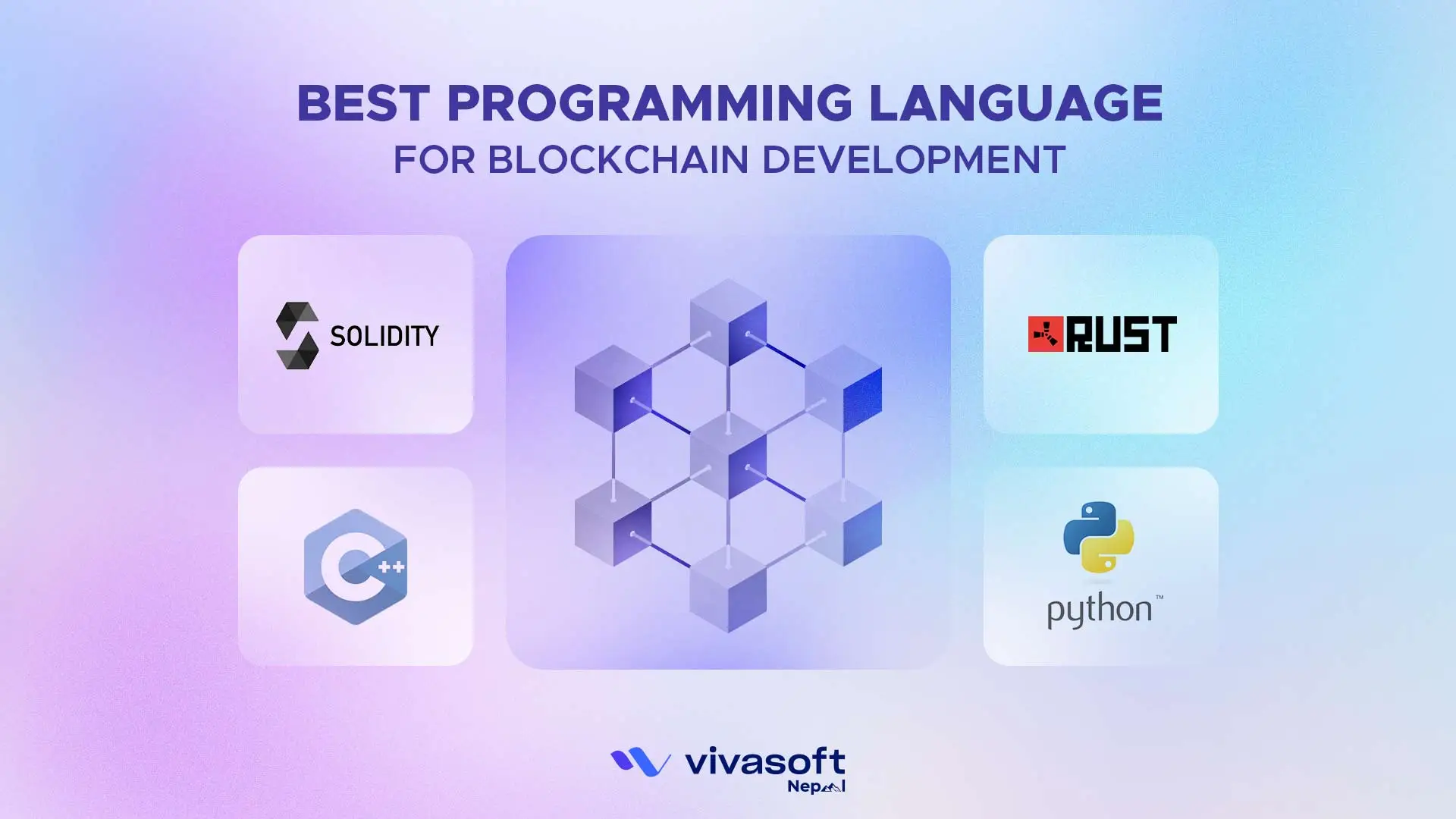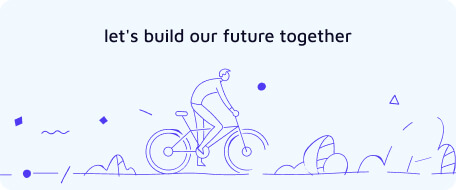The first time a blockchain project runs into scaling problems, the reason often traces back to the language behind it. Performance slows, security gaps show, and upgrades become expensive. Some teams push through by rewriting parts of the code. Others discover too late that the wrong choice locks them in.
Picking the best programming language for blockchain development is never about trend chasing. It shapes security, speed, and adoption. No single option works for every project. The right fit depends on goals, resources, and long-term vision.
10 Best Programming Languages for Blockchain Development
The most used blockchain platforms run on a narrow set of languages. Each balances security, speed, and scalability in different ways, whether for enterprise blockchain solutions or decentralized apps.
1. Solidity
Solidity began as a way to bring contracts into code. At first glance, it looks a lot like JavaScript or C++, which gives developers a familiar entry point. But its exact strength lies in how it connects directly to the Ethereum Virtual Machine.
Crowdfunding platforms, decentralized exchanges, voting protocols, even multi-signature wallets- they all are built on this foundation. Solidity makes those ideas executable, and once deployed, they keep running on-chain without the need for a middleman. That’s why much of DeFi, NFTs, and DAO governance still runs through this language.
Features of Solidity
- Object-oriented language for smart contracts
- Runs on Ethereum Virtual Machine (EVM)
- Syntax influenced by JavaScript, C++, Python
- Statically typed with curly-brace structure=
- Supports inheritance and modular design
- Application Binary Interface (ABI) integration
- Turing-complete for complex logic
Pros and Cons of Solidity
| Pros | Cons |
|---|---|
| Familiar syntax makes it easier to learn | Contracts can’t be altered once deployed |
| Huge ecosystem across Ethereum and EVM-compatible chains | Security risks can lead to irreversible losses |
| Powers DeFi, NFTs, DAOs, and dApps | Limited use outside blockchain |
| Large community, tooling, and resources available | Testing and debugging remain complex |
2. Rust
Rust was designed with one focus, to make code run at near-metal speed without leaving the door open for memory bugs. Solana’s ultra-fast network, NEAR’s sharded architecture, and Polkadot’s cross-chain framework all lean on Rust because it keeps high throughput stable under heavy load. Teams use it when scalability and safety have to exist side by side.
Features of Rust
- Ownership model
- Zero-cost abstractions
- Concurrency support
- Memory efficiency
- Reliability
- WASM compatibility
- Mutable state management
- Strong type system
Pros and Cons of Rust
| Pros | Cons |
|---|---|
| High performance close to C/C++ | Steep learning curve |
| Strong memory safety guarantees | Toolchain feels complex for beginners |
| WASM support enables portability | Smaller blockchain-specific ecosystem |
3. Go (Golang)
Go entered the blockchain through the back door. Ethereum needed a reliable client, and Geth (written in Go) became the standard. That single implementation carried most of the network for years, and from there Go spread. Cosmos built its SDK in Go, Tendermint’s consensus engine relied on it, and Hyperledger Fabric turned it into enterprise infrastructure.
What makes Go fit so naturally is its concurrency model. Blockchains need to validate transactions, propagate blocks, and keep thousands of nodes in sync- all at once. Goroutines and channels make that orchestration far less painful.
Features of Go
- Concurrency with goroutines and channels
- Simple, readable syntax
- Fast compilation and execution
- Strong standard library for networking
- Statically typed with garbage collection
- Cross-platform portability
- Easy deployment with static binaries
- Large active community
Pros and Cons of Go
| Pros | Cons |
|---|---|
| Clean syntax, quick to learn | Not designed for smart contract logic |
| Built-in concurrency primitives | Smaller blockchain-specific tooling than Solidity |
| Strong networking support | Limited standard library compared to older languages |
| Easy deployment, portable binaries | Debugging concurrent code can be tricky |
4. Vyper
Vyper was built as a contract language for Ethereum that favors safety over flexibility. The syntax looks like Python, but most of Python’s dynamic features are stripped away. No inheritance, no modifiers, no recursive calls, not even infinite loops.
Developers reach for Vyper when clarity and auditability matter more than squeezing every ounce of complexity into a contract. That’s why platforms handling pooled assets or staking systems, like Lido or yEarn, lean on it. The code is easier to read and verify, while harder to exploit.
Features of Vyper
- Python-like syntax
- Restricted feature set for security
- Explicit EVM targeting
- High readability and auditability
- Early error detection
- Predictable gas costs
- Security-focused compiler design
Pros and Cons of Vyper
| Pros | Cons |
|---|---|
| Simple, readable syntax | Smaller ecosystem and fewer tools |
| Security-oriented restrictions | Lacks advanced features (inheritance, modifiers) |
| Easier auditing and verification | Not as expressive for complex logic |
| Reduces risk of common exploits | Limited community compared to Solidity |
5. JavaScript/TypeScript
JavaScript started as the language of the browser. Then Node.js pushed it server-side. That single move made it useful for more than websites, it became a bridge in blockchain. Wallet prompts, token swaps, NFT mints, DAO dashboards – all rely on JavaScript to translate blockchain logic into actions people can click.
TypeScript – a superset of Javascript extends this by reducing runtime surprises, which matters when mistakes cost real money. The language works both in browsers and servers, so entire dApps can be stitched together without switching stacks. This makes it the default glue between blockchains and the people using them. Its flexibility provides significant support for enterprise blockchain solutions.
Features of Javascript/Typescript
- Browser + Node.js support
- Libraries: web3.js, ethers.js
- Frameworks: Hardhat, Truffle
- TypeScript adds type safety
- Large ecosystem of packages
- Fast prototyping cycles
Pros and Cons of Javascript/Typescript
| Pros | Cons |
|---|---|
| Massive ecosystem and community | Slower than compiled languages |
| Familiar to most developers | Security risks if best practices ignored |
| Works across frontend and backend | Not suited for protocol-level logic |
| TypeScript reduces runtime errors | Reliance on third-party libraries |
| Strong tooling for dApps | Bottlenecks under heavy load |
6. Python
Python is not the language that runs blockchains, but it is the language that makes blockchains usable. The syntax is clean, so code can be written, tested, and refactored fast. That speed of iteration is why it became the backbone for toolkits like web3.py on Ethereum, Brownie for Solidity testing, and AlgoKit for Algorand.
Features of Python
- Clean, readable syntax
- Vast open-source libraries
- Frameworks: web3.py, Brownie, AlgoKit
- Contract language: Vyper (Python-based)
- Multi-chain support (Ethereum, Algorand, Celo, NEO)
- Strong developer community
Pros and Cons of Python
| Pros | Cons |
|---|---|
| Easy to learn and audit | Slower than compiled languages |
| Rapid prototyping | Global Interpreter Lock limits scaling |
| Huge open-source libraries | Heavy cryptography runs less efficiently |
| Works across multiple blockchains | Not ideal for low-level protocol code |
7. C++
C++ has been in use since the mid-80s, and yet it still sits at the center of blockchain infrastructure. Bitcoin’s core codebase was written in C++, which set the standard for many chains that followed- Litecoin, Dogecoin, Ripple, Stellar, Monero, EOS.
The reason is straightforward, blockchains need raw performance and precise control over resources. Every transaction validated, every block propagated across the network, relies on efficient memory handling and concurrency; and C++ provides that.
Features of C++
- Low-level memory and CPU control
- Multi-threading support
- Polymorphism (compile-time and run-time)
- Abstraction and encapsulation\
- Move semantics
- Standard Template Library (STL)
Pros and Cons of C++
| Pros | Cons |
|---|---|
| Fine-grained control over system resources | Steep learning curve |
| High execution speed and scalability | Verbose, sometimes redundant syntax |
| Strong concurrency handling | No built-in garbage collection |
| Mature ecosystem and tooling | Debugging can be complex |
| Proven track record in major blockchains | Less beginner-friendly |
8. Java
The “write once, run anywhere” principle through JVM makes Java a natural fit for distributed systems that need to run across environments without friction. That’s why enterprise-focused chains like Corda lean on it, and why NEO or IOTA make room for it. Smart contracts written in Java feel approachable for developers already used to backend work.
Features of Java
- JVM-based portability (“write once, run anywhere”)
- Object-oriented design
- Automatic memory management
- Multithreading and concurrency support
- Large standard library and APIs
- Strong security model
Pros and Cons of Java
| Pros | Cons |
|---|---|
| Runs across platforms reliably | Slower execution compared to native code |
| Mature ecosystem and tooling | Verbose syntax |
| Large pool of experienced developers | Higher memory overhead |
| Strong support for enterprise-grade systems | Learning curve for blockchain-specific libraries |
9. Move
Move was designed from the ground up for blockchain, not repurposed from some other ecosystem. It came out of Meta’s Diem project, but the language itself didn’t die when the chain shut down.
In most languages, a token is just data which can be copied, reassigned, even accidentally overwritten. In Move, assets are resources. They can’t be duplicated or destroyed unless the rules explicitly allow it. That shift makes it harder to lose funds to simple coding errors or classic exploits.
This is why chains like Aptos and Sui adopted it. For developers, it feels less like managing variables and more like codifying ownership and transactions directly into the system’s logic.
Features of Move
- Resource-oriented programming model
- Strong static type system
- Modular architecture for reusable code
- Move Virtual Machine (MVM)
- Bytecode verification
- Formal verification support
Pros and Cons of Move
| Pros | Cons |
|---|---|
| Assets are enforced as unique, reducing duplication or theft risks | Smaller ecosystem compared to EVM and Solidity |
| Security-first design with formal verification tools | Learning curve due to resource-oriented model |
| Efficient execution on Move VM | Tooling and libraries still early-stage |
| Modular and composable structure for scalable apps | Less developer community support than older languages |
10. Cairo
Cairo is a language built for a different kind of blockchain problem. Instead of just running code, it’s about being able to prove that code ran correctly without everyone having to re-run it. That’s the whole idea behind STARK proofs, and Cairo was designed from the ground up to fit inside that world.
It’s the language of Starknet, which sits on top of Ethereum. Contracts written in Cairo don’t just execute, they can be verified in a way that scales far beyond what’s possible with EVM chains. That’s why projects like onchain games, DeFi platforms, and even provable AI computations are gravitating toward it.
Features of Cairo
- Rust-inspired syntax
- zk-STARK friendly compilation
- Intermediate layer (Sierra) for safety
- CairoVM as the execution environment
- Native to Starknet
Pros and Cons of Cairo
| Pros | Cons |
|---|---|
| Efficient proof generation with STARKs | Smaller dev ecosystem compared to Solidity |
| Safer execution with Sierra intermediate layer | Learning curve is steeper without EVM familiarity |
| Expanding into use cases beyond DeFi (gaming, AI, etc.) | Less documentation and fewer tutorials than EVM |
How to Choose the Right Programming Language for Blockchain Development?
Choosing a blockchain language is less about “which is best” and more about “what will survive in production.” Once code is deployed, rollbacks don’t exist. The wrong fit means wasted audits, brittle integrations, or systems that choke under load.
Project Requirements and Use Case
Code for a DeFi protocol doesn’t mirror code for an IoT supply chain. If the system moves real money, languages with formal verification (Vyper, Rust) cut risk. For enterprise workflows, Java integrates neatly with legacy stacks. Matching language features with the project’s risk profile is the difference between a hackathon demo and a production-grade system.
Target Blockchain Platform
Chains enforce their own rules. Ethereum equals Solidity; Solana leans on Rust; Corda trusts Java. Even if another language looks elegant, tooling friction will kill velocity. A chain’s supported stack isn’t optional, it dictates compilers, audits, and production paths. Ignoring this is like writing iOS apps without Swift- possible, but slow suicide.
Team Expertise and Resources
A veteran Java shop building on Corda will outpace a Rust rookie team on Solana. Language choice isn’t isolated; it’s bound to hiring pipelines, dev salaries, and the libraries the team can actually maintain. Throwing engineers into an unfamiliar language rarely produces secure, audited code- it produces tech debt in disguise.
Performance and Scalability Requirements
If the system needs microsecond-level settlement, Solidity won’t cut it. Rust handles parallelism and memory control, making it suited for Solana-scale throughput. Java and Go excel in backend-heavy or enterprise workloads with many concurrent processes. Language performance isn’t just about raw speed. It’s about whether the chain and language combo sustain growth without collapsing under stress.
Security and Reliability
A misplaced semicolon in blockchain code isn’t just a bug. It can be an exploit vector. Rust enforces memory safety at compile time, reducing whole classes of vulnerabilities. Solidity carries battle-tested libraries but also a graveyard of hacks. The right choice balances developer freedom with safety rails, depending on how catastrophic failure would be in the chosen use case.
Ecosystem and Community Support
Languages aren’t just syntax, they’re survival networks. Solidity dominates because it has the largest pool of auditors, libraries, and devs. Rust is gaining similar gravity through Solana and Polkadot. Picking a niche language with no audit firms or Stack Overflow footprint might look clean on paper but turns into isolation when things break in production.
Conclusion
Picking a language for blockchain feels like it should be straightforward. But it rarely is. A system built for payments does not face the same tradeoffs as one built for supply chains.
A game that needs fast execution will not use the same stack as a protocol securing billions. No single choice fits every case. The better move is to work with a blockchain solution provider that can match your goals, budget, and scale with a proper and cost-effective solution.
FAQs
Which language is best for writing secure smart contracts for Ethereum?
Solidity is the most widely used for Ethereum smart contracts but Vyper is great if security and auditability are your top priorities.
How do Rust and Go compare for building a Layer‑1 blockchain?
Rust offers memory safety and high performance, ideal for scalable Layer‑1 chains like Solana. Go is easier to learn and excels at building blockchain nodes and distributed systems.
Why is Solidity still dominant for dApp and smart contract development?r?
Solidity was built for Ethereum. It has the largest ecosystem, libraries, tooling and community making it the default choice for most dApp projects.
How will Move and Sui languages shape future blockchain security?
Move’s resource-oriented model ensures assets can’t be duplicated or lost, improving security for DeFi and asset-based apps. Sui builds on this to enable high parallel execution and safer smart contracts.
Which language choice gives me the easiest path to enterprise integration?
Java and C# are best for enterprise blockchain, as they integrate easily with existing systems and have strong enterprise tooling. Go is also good for scalable backend solutions.













